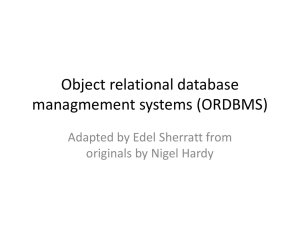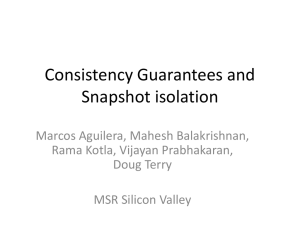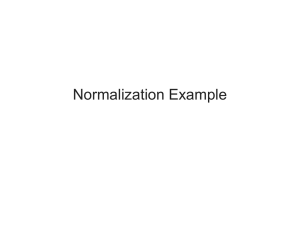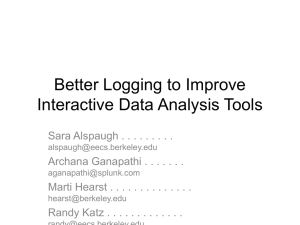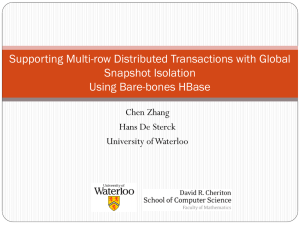Chapter 5 - Faculty Website Listing
advertisement
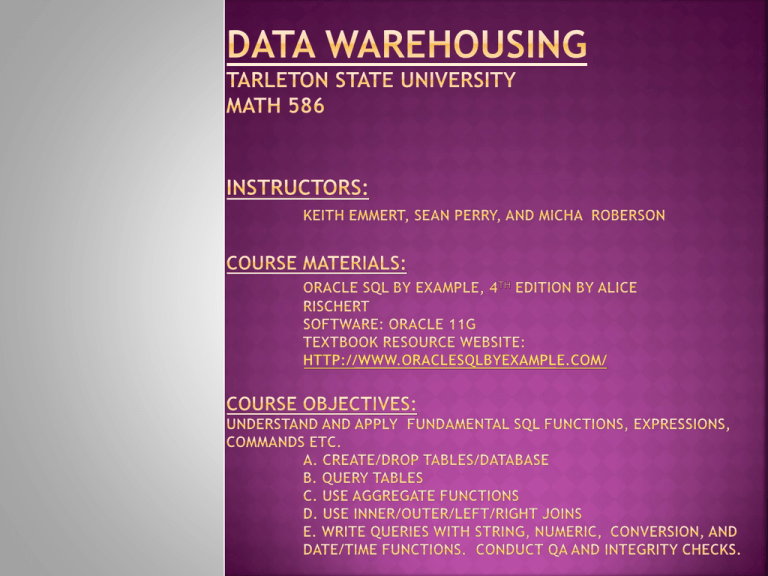
The DATE data type consists of a date and time. The default date format is determined by the database NLS_DATE_FORMAT parameter. To change how a date is displayed, we use the TO_CHAR() function combined with a format mask. The TO_DATE() function does the reverse and changes a char/varchar data type into a date data type with the appropriate format mask. SELECT last_name, registration_date, TO_CHAR(registration_date, ‘MM/DD/YYYY’) AS “Formatted” FROM STUDENT WHERE student_id IN (123,161,190); FORMAT DESCRIPTION YYYY Four-digit year YEAR Year, spelled out RR Two-digit year, based on century. MM Two-digit month. MON Three-letter abbreviation of the month, in uppercase. MONTH Month, spelled out, in uppercase letters and padded with blanks. Month Month, spelled with first letter uppercased and padded with blanks to a length of nine characters. DD Numeric day (1-31) DAY Day of the week, spelled out, in uppercase letters and padded with blank to a length of nine characters. DY Three-letter abbreviation of the day of the week, in uppercase letters. D Day of the week number(1-7), where Sunday is day 1, etc. DDD Day of the year (1-366) FORMAT DESCRIPTION DL Day long format; the equivalent format mask is fmDay, Month DD, YYYY. HH or HH12 Hours (0-12) HH24 Hours in military format(0-23). MI Minutes (0-59) SS Seconds (0-59) SSSSS Seconds past midnight (0-86399) AM or PM Meridian indicator TS Short time format; the equivalent format mask is HH:MI:SS AM. WW Week of the year (1-53) W Week of the month (1-5) Q Quarter of the year. By default Oracle pads the format Month with up to 9 spaces. To eliminate the extra spaces, we can put fm at the beginning of the format mask. Select last_name, TO_CHAR(registration_date, ‘fmMonth ddth, YYYY’) “Eliminating Spaces”, TO_CHAR(registration_date, ‘Month ddth, YYYY’) “Not Eliminating Spaces” From student where student_id IN (123,161, 190); Format Mask Example DD-Mon-YYYY HH2:4:MI:SS 12-Apr-2009 17:00:00 (case matters) MM/DD/YYYY HH:MI PM 04/12/2009 5:00 PM Month April fmMonth DDth, YYYY April 12th, 2009 Day Sunday DY SUN Qth YYYY 2nd 2009 (this shows the 2nd quarter of 2009) Ddspth Twelfth (Spells out the date) DD-MON-RR 12-APR-09 Convert the comparison string to a date. The format mask needs to agree with your text literal; otherwise, Oracle will not be able to interpret the text literal correctly and will return an error. SELECT last_name, registration_date FROM student WHERE registration_date = TO_DATE(‘22-JAN-2007’, ‘DDMON-YYYY’); Without a format mask, Oracle can implicitly perform a conversion if the text literal to the DATE data type when the text literal is in the default format, determined by the NLS_DATE_FORMAT. SELECT last_name, registration_date FROM student WHERE registration_date =‘22-JAN-07’; SELECT last_name, registration_date FROM student WHERE registration_date =‘22-JAN-2007’; You can modify the behavior by changing the Windows registry, or within a tool such as SQL Developer, by selecting Tools, Preferences, Database, NLS Parameters and using the options there. Or by issuing an alter session command to temporarily set the value. ALTER ESESSION SET NLS_DATE_FORMAT = ‘DD-MON-RRRR’; We still have to deal with dates in the twentieth century. The special RR format mask interprets the twodigit year from 50 until 99 as the prior century, 1950-1999, and 00 until 49 are interpreted as the current century, 2000-2049. SELECT grade_type_code, description, created_date FROM grade_type WHERE created_date = ‘31-DEC-98’; SELECT SYS_CONTEXT(‘USERENV’, ‘NLS_DATE_FORMAT’) FROM dual; If no time component was included when the data was entered, Oracles assumes that the time is midnight. SELECT last_name, TO_CHAR(registration_date, ‘DD-MON-YYYY HH24:MI:SS’) FROM student WHERE registration_date = TO_DATE(‘22JAN-2007’, ‘DD-MON-YYYY’); The TRUNC function can also take a DATE data type as an input parameter, which interprets the time as midnight. SELECT student_id, TO_CHAR(enroll_date, ‘DD-MON-YYYY HH24:MI:SS’) FROM enrollment WHERE TRUNC(enroll_date) = TO_DATE(‘07-FEB-2007’, ‘DDMON-YYYY’); You can specify a date in the ANSI format DATE ‘YYYY-MM-DD’.LTRIM(RTRIM(in)), functions can be nested. SELECT student_id, TO_CHAR(enroll_Date, ‘DD-MON-YYYY HH24:MI:SS’) FROM enrollment WHERE enroll_date >= DATE ‘2007-02-07’ and Enroll_date < DATE ‘2007-02-08’; If you want to include the time portion, use the ANSI TIMESTAMP keyword, with the literal defined as YYYY-MM-DD HH24:MI:SS. SELECT student_id, TO_CHAR(enroll_Date, ‘DD-MON-YYYY HH24:MI:SS’) FROM enrollment WHERE enroll_date >= TIMESTAMP ‘2007-02-07 00:00:00’ and Enroll_date < TIMESTAMP ‘2007-02-08 00:00:00’; The SYSDATE function returns the computer operating system’s current date and time and does not take any parameters. When connecting to a server via a client machine, it returns the date and time of the machine hosting the database, not the date and time of your client machine. SELECT SYSDATE, TO_CHAR(SYSDATE, ‘DDMON-YYYY HH24:MI’) FROM dual; SELECT TO_DATE(‘01-JAN-2015’, ‘DD-MONYYYY’)-TRUNC(SYSDATE) int, TO_DATE(‘01-JAN-2015’, ‘DD-MON-YYYY’)SYSDATE dec FROM dual; SELECT TO_CHAR(SYSDATE, ‘MM/DD HH24:MI:SS’) now, TO_CHAR(SYSDATE+3/24, ‘MM/DD HH24:MI:SS’) as now_plus_3hrs, TO_CHAR(SYSDATE+1, ‘MM.DD HH24:MI:SS’) tomorrow, TO_CHAR(SYSDATE+1.5, ‘MM/DD HH24:MI:SS’) AS “36HRS from now” FROM dual; SELECT TO_CHAR(TO_DATE(’12/31/1999, ‘MM/DD/YYYY’), ‘MM/DD/YYYY DY’) “New Year’s Eve”, TO_CHAR(NEXT_DAY(TO_DATE(‘12/31/1999’, ‘MM/DD/YYYY’), ‘SUNDAY’), ‘MM/DD/YYYY DY’) “First Sunday” FROM dual; The ROUND function allows you to round days months, or years. SELECT TO_CHAR(SYSDATE, ‘DD-MON-YYYY HH24:MI’) now, TO_CHAR(ROUND(SYDATE), ‘DD-MON-YYYY HH24:MI’) day, TO_CHAR(ROUND(SYSDATE, ‘MM’), ‘DD-MON-YYYY HH24:MI’) mon FROM dual; The EXTRACT function extracts the year, month, or day from a column of the DATE data type column. SELECT TO_CHAR(start_date_time, ‘DD-MON-YYYY’) “Start Date”, EXTRACT(MONTH FROM start_date_time) “Month”, EXTRACT(YEAR FROM start_date_time) “Year”, EXTRACT(DAY FROM start_date_time) “Day” FROM section WHERE EXTRACT(MONTH FROM start_date_time) =4 ORDER BY start_date_time; FUNCTION PURPOSE RETURN DATA TYPE ADD_MONTHS(date, integer) Adds or subtracts the number of months from a certain date DATE MONTHS_BETWEEN(date2 , date1) Determines the number of months between two dates. NUMBER LAST_DAY(date) Returns the last date of the month. DATE NEXT_DAY(date, day_of_the_week) Returns the first day of the week that is later than the date parameter passed. DATE TRUNC(DATE) Ignores the hours, minutes, and seconds on the DATE data type. DATE ROUND(date,[,format_m ask]) Rounds to various DATE components, depending on the optional supplied format mask. DATE NEW_TIME(date, current_time_zone, new_time_zone) Returns the date and time in another time zone. DATE The The TIMESTAMP data type allows you to store optional fractional seconds with a precision of up to nine digits; default is six. In the format mask, ‘DD-MON-RR HH.MI.SS.FF AM’, the fractional seconds are expressed with the FF format mask. To change the precision, you add a number from 1 to 9 after FF mask. EX., ‘DDMON-RR HH.MI.SS.FF5 AM’, The TIMESTAMP Data Type TIMESTAMP with TIME ZONE Data Type This data type returns the date, time, fractional seconds, and the time zone displacement value, also called the time zone offset value. It is expressed as the difference between your local time and Greenwich Mean Time(GMT), now called Coordinated Universal Time(UTC). This data type stores the date and time values of the database’s own local time zone. When the user retrieves data, the returned values are automatically converted to represent each individual user’s time zone. When performing arithmetic on this data type, Oracle automatically converts all values to UTC before doing the calculation and then converts the value back to the local time. DATE COMPONENT VALID VALUES YEAR -4712 – 9999 (excluding year 0) MONTH 01-12 DAY 01-31 HOUR 00-23 MINUTE 00-59 SECOND 00-59 (optional precision up to nine digits on TIMESTAMP, TIMESTAMP WITH TIME ZONE, and TIMESTAMP WITH LOCAL TIME ZONE data type). TIMEZONE_HOUR -12-+13 TIMEZONE_MINUTE 00-59 FUNCTION PURPOSE RETURN DATA TYPE SYSDATE Returns the database server operating system’s current date and time. DATE CURRENT_DATE Returns the date and time of the local session time zone, in the DATE data type. DATE CURRENT_TIMESTAMP Returns the individual’s session date and time in the data type TIMESTAMP WITH TIME ZONE value. TIMESTAMP WITH TIME ZONE SYSTIMESTAMP Returns the date, time, and fractional seconds and time zone of the server. TIMESTAMP WITH TIME ZONE LOCALTIMESTAMP Returns in the TIMESTAMP format the current date and time in the local session time. TIMESTAMP SESSIONTIMEZONE Returns the time zone offset value of the session time zone or the time zone region name, depending on the setup of the database. VARCHAR2 DBTIMEZONE Returns the time zone offset value of the database server time zone or time zone region name, depending on the setup of the database. VARCHAR2 Returns the current date and time, including the fractional seconds in the TIMESTAMP format, of the local user’s session time. SELECT LOCALTIMESTAMP FROM DUAL; Includes the fractional seconds with up to nine digits of precision, using the database’s time zone, not that of the client machine. SELECT SYSTIMESTAMP FROM DUAL; Returns the current session’s time in the data type TIMESTAMP WITH TIME ZONE value. Similar to LOCALTIMESTAMP, except this returns the time zone displacement value as well. SELECT CURRENT_TIMESTAMP, LOCALTIMESTAMP FROM DUAL; This function returns the date and time in the session’s time zone in the data type DATE. SELECT TO_CHAR(CURRENT_DATE, ‘DDMON-YYYY HH:MI:SS PM’) FROM DUAL; Because an individual user may be in a different time zone than the database server, you can execute different functions based on what you want to accomplish. The SESSIONTIMEZONE function returns the session’s time zone displacement value; the DBTIMEZONE function returns the server’s time zone displacement value. If none has been set it returns UTC(+00:00). SELECT SESSIONTIMEZONE FROM DUAL; You can change the time zone for an individual session by using the ALTER SESSION command. The setting remains until you exit the session. ALTER SESSION SET TIME_ZONE = ‘America/New_York’; ALTER SESSION SET TIME_ZONE = dbtimezone; ALTER SESSION SET TIME_ZONE = local; This function extracts the UTC from a passed date and time value. SELECT SYS_EXTRACT_UTC(TIMESTAMP ‘2009-02-11 7:00:00 -8:00’) “West coast to UTC”, SYS_EXTRACT_UTC(TIMESTAMP ‘2009-02-11 10:00:00 -5:00’) “East coast to UTC” FROM DUAL; The TZ_OFFSET(time_zone) function returns the time difference between UTC and the passed time zone value in VARCHAR2. SELECT TZ_OFFSET(‘Europe/London’) “London”, TZ_OFFSET(‘America/New_York’) “NY”, TZ_OFFSET(‘America/Chicago’) “Chicago”, TZ_OFFSET(‘America/Denver’) “Denver”, TZ_OFFSET(‘America/Los_Angeles’) “LA” FROM DUAL; The EXTRACT function mentioned previously can be used on TIMESTAMP and TIMESTAMP WITH TIME ZONE data types. SELECT EXTRACT(HOUR FROM TIMESTAMP ‘2009-02-11 15:48:01:123’) hour, EXTRACT(MINUTE FROM TIMESTAMP ‘2009-02-11 15:48:01:123’) minute, EXTRACT(SECOND FROM TIMESTAMP ‘2009-02-11 15:48:01:123’) second, EXTRACT(YEAR FROM TIMESTAMP ‘2009-02-11 15:48:01:123’) year, EXTRACT(MONTH FROM TIMESTAMP ‘2009-02-11 15:48:01:123’) month, EXTRACT(DAY FROM TIMESTAMP ‘2009-02-11 15:48:01:123’) day FROM DUAL; SELECT col_timestamp_w_tz, EXTRACT(TIMEZONE_HOUR FROM col_timestamp_w_tz) tz_hour, EXTRACT(TIMEZONE_MINUTE FROM col_timestamp_w_tz) tz_minute, EXTRACT(TIMEZONE_REGION FROM col_timestamp_w_tz) tz_region, EXTRACT(TIMEZONE_ABBR FROM col_timestamp_w_tz) tz_abbr FROM date_example; COL_TIMESTAMP_W_TZ TZ_HOUR TZ_MIN TX_REGION TZ_ABBR 24-FEB-09 04.25.32.000000 PM -05:00 -5 0 UNKNOWN UNK FUNCTION PURPOSE RETURN DATA TYPE TO_TIMESTAMP(char [,format_mask]) Converts text to the TIMESTAMP data type, based on the format_mask. TIMESTAMP TO_TIMESTAMP_TZ(char [,format_mask]) Converts text or a database column of VARCHAR2 or CHAR data type to a TIMESTAMP WITH TIME ZONE data type, based on the format_mask. TIMESTAMP WITH TIME ZONE TO_DATE(char [,format_mask) Converts text to a DATE data type. AS with all other datetime-related conversion functions, format_mask is optional if the value conforms to the NLS_DATE_FORMAT; otherwise, format_mask must be specified. DATE TO_CHAR(date [,format_mask) Converts all datetime-related data types into VARCHAR2 to display it in a different format than the default date format. VARCHAR2 FROM_TZ(timestamp, hour_min_offset) Converts a TIMESTAMP value into a TIMESTAMP WITH TIME ZONE data type. TIMESTAMP WITH TIME ZONE CAST Converts TIMESTAMP, TIMESTAMP WITH TIME ZONE, and TIMESTAMP WITH LOCAL TIME ZONE VARIOUS A datetime expression can be a column of data type TIMESTAMP WITH TIME ZONE, TIMESTAMP WITH LOCAL TIME ZONE, or TIMESTAMP or an expression that results in any of the three data types. Any of these expression can be shown in various time zones with the keywords AT TIME ZONE. SELECT col_timestamp_w_tz AT TIME ZONE ‘America/Los_Angeles’ FROM date_example; COL_TIMESTAMP_W_TZATTIMEZONE’AMERICA/LOS_ANGELES 24-FEB-09 01.25.32.000000 PM AMERICA/LOS_ANGELES SELECT col_timestamp_w_tz AT TIME ZONE DBTIMEZONE FROM date_example; COL_TIMESTAMP_W_TZATTIMEZONEDBTIMEZONE 24-FEB-09 04.25.32.000000 PM -05:00 Oracle has two interval data types: INTERVAL YEAR TO MONTH and INTERVAL DAY TO SECOND. These data types store the difference between two date values. DATA TYPE PURPOSE AND EXAMPLES OF LITERALS INTERVAL YEAR[(year_precision )] TO MONTH Values are expressed in years and months. The default year precisions is two digits. Examples: INTERVAL DAY[(day_precision)] TO SECOND [(fractional_seconds_ precision)] Values are expressed in days, hours, minutes, and seconds. The default precision for the DAY is 2; the fractional seconds precision has a six-digit default value. Examples: INTERVAL ‘3-2’ YEAR TO MONTH (Translates to 3 years and 2 months). INTERVAL ‘2’ YEAR (2 years) INTERVAL ‘4’ MONTH (4 months) INTERVAL ‘36’ MONTH (36 months, or 3 years) INTERVAL ’30’ DAY (30 days) INTERVAL ‘200’ DAY(3) (This translate to 200 days; because the literal exceeds the default DAY precision of 2, you need to explicitly specify the precision. INTERVAL ‘12:51’ HOUR TO MINUTE (12 hours and 51 minutes) INTERVAL ‘15’ MINUTE (15 minutes) INTERVAL ‘3 5:10:15.10’ DAY TO SECOND (3 days, 5 hours, 10 minutes, 15 seconds, and 10 fractional seconds) Note that the components must be contiguous; for example, you cannot skip the minute component between the hour and second components. Intervals can be used for calculations. SELECT student_id, registration_date, registration_date + TO_YMINTERVAL(‘01-06) “Grad. Date” FROM STUDENT WHERE student_id =123; The EXTRACT function can be used. SELECT EXTRACT(MINUTE FROM INTERVAL ‘12:51’ HOUR TO MINUTE) FROM DUAL; FUNCTION PURPOSE RETURN DATA TYPE TO_YMINTERVAL(char) Converts a text literal to an INTERVAL YEAR TO MONTH data type. INTERVAL YEAR TO MONTH TO_DSINTERVAL(char) Converts a text literal to an INTERVAL DAY TO SECOND data type. INTERVAL DAY TO SECOND NUMTOYMINTERVAL(number, ‘YEAR’) NUMTOYMINTERVAL(number, ‘MONTH’) Converts a number to an INTERVAL YEAR TO MONTH interval. INTERVAL YEAR TO MONTH NUMTODSINTERVAL(number, ‘DAY’) Converts a number to an INTERVAL DAY TO SECOND literal. Instead of the DAY parameter, you can pass HOUR, MINUTE, or SECOND instead. INTERVAL DAY TO SECOND EXTRACT(MINUTE FROM interval data type) Extracts specific components(for example, YEAR, MONTH, DAY, HOUR, MINUTE, SECOND). NUMBER As an alternative to the NUMTODSINTERVAL or the NUMTOYMINTERVAL function, you can use an interval expression, which can be either DAY TO SECOND or YEAR TO MONTH. SELECT col_timestamp, (SYSTIMESTAMP – col_timestamp) DAY(4) TO SECOND “Interval Day to Second” FROM date_example; COL_TIMESTAMP Interval Day to Second 24-FEB-09 04.25.32.000000 PM 38 20:23:29.218000 SELECT col_timestamp, (SYSTIMESTAMP – col_timestamp) YEAR TO MONTH “Interval Year to Month” FROM date_example; COL_TIMESTAMP Interval Year to Month 24-FEB-09 04.25.32.000000 PM 0-1 The OVERLAPS operator is useful to determine whether two time periods overlap. The syntax is event OVERLAPS event. (start_event_date_time, end_event_start_time) or (start_event_date_time, interval_duration) SELECT meeting_id, TO_CHAR(meeting_start, ‘dd-mon-yyyy hh:mi pm’) “Start”, TO_CHAR(meeting_end, ‘dd-mon-yyyy hh:mi pm’) “END” FROM meeting WHERE (meeting_start, meeting_end) OVERLAPS (to_date(’01-JUL-2009 3:30 PM’, ‘DD-MON-YYYY HH:MI PM’), INTERVAL ‘2’ HOUR) MEETING_ID Start END 2 01-JUL-2009 03:00 PM 01-JUL-2009 04:30 PM Although Oracle can implicitly convert a data type, it is always best to explicitly specify the conversion function to make sure the data types agree. To do this we can use the CAST function. The CAST function converts from one data type to another. The syntax is as follows. CAST(expression AS data_type) It can be used in the select clause, the where clause, or in nested queries. SELECT section_id, TO_CHAR(start_date_time, ‘DD-MON-YYYY HH24:MI:SS’) FROM SECTION WHERE start_date_time >= CAST(‘01-JUL-2007’ AS DATE) and start_date_time <CAST(‘01-AUG-2007’ AS DATE); SELECT CAST(‘1-6’ AS INTERVAL YEAR TO MONTH) “CAST”, TO_YMINTERVAL(‘1-6’) “TO_YMINTERVAL”, NUMTOYMINTERVAL(1.5, ‘YEAR’) “NUMTOYMINTERVAL” FROM DUAL; Some of Oracle’s built-in data types, such as the various LOB, LONG RAW, and LONG, cannot be converted from one data type to another using CAST. FUNCTION PURPOSE TO_NUMBER(char[,format_mask]) Converts a VARCHAR2 or CHAR to a NUMBER TO_BINARY_FLOAT(expression[,format_mask]) Converts a character or numeric value to BINARY_FLOAT TO_BINARY_DOUBLE(expression[,format_mask]) Converts a character or numeric value to BINARY_DOUBLE TO_CHAR(datetime[,formatmask]) Converts a datetime value to a VARCHAR2 TO_CHAR(number[,format_mask]) Converts a NUMBER to a VARCHAR2 TO_CLOB(char) Converts a VARCHAR2 or CHAR to a CLOB TO_DATE(char[,format_mask]) Converts a VARCHAR2 or CHAR to a DATE. CAST(expression AS data type) Converts from one data type to another. Can be used for Oracle’s most commonly used data types and for user_defined data types. The TO_CHAR conversion function is useful not only for data conversions between different data types but also for formatting data. SELECT course_no, cost, TO_CHAR(cost, ‘999,999’) formatted FROM course WHERE course_no <25; The SQL*PLUS column format command can be used here. COL “SQL*PLUS” FORMAT 999,999 SELECT course_no, cost “SQL*PLUS”, TO_CHAR(cost, ‘999,999’) “CHAR” FROM course WHERE course_no <25; FORMAT MASK EXAMPLE VALUE APPLIED TO_CHAR FUNCTION RESULT 999,990.99 .45 TO_CHAR(.45, ‘999,990.99’) 0.45 (Note the leading zero) $99,999.99 1234 TO_CHAR(1234,’$99,999.99’) $1,234.00 0999 123 TO_CHAR(123, ‘0999’) 0123 L9999.99 1234.99 TO_CHAR(1234.99, ‘L9999.99’) $1234.99 (local currency) L99G999D99 1234.56 TO_CHAR(1234.56, ‘L99G999D99’) $1,234.56 (local values for currency, group, and decimal separators) 999PR -123 TO_CHAR(-123, ‘999PR’) <123> 999MI -123 TO_CHAR(-123, ‘999MI’) 123- 999s -123 TO_CHAR(-123, ‘999s’) 123- S999 -123 TO_CHAR(-123,’s999’) -123 999 123.59 TO_CHAR(123.59, ‘999’) 124 (Note the rounding) Quiz will be given at the beginning of our next class


